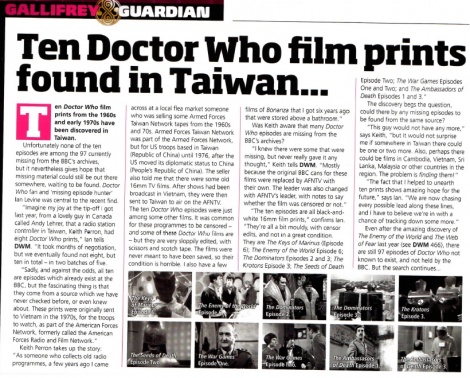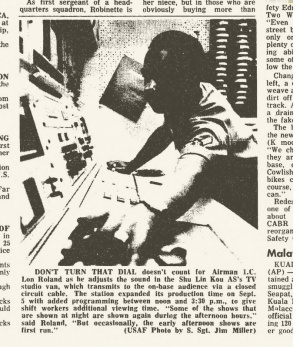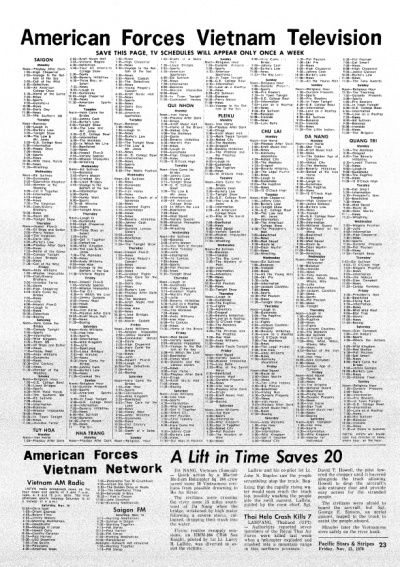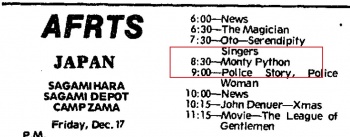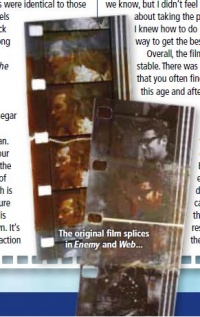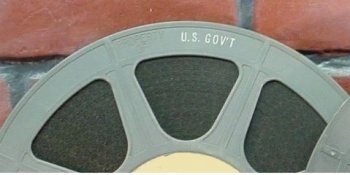Taiwan Prints
The Mystery of the "Taiwan Prints"
On 19 December 2013 it was announced that five black and white episodes had been found in Taiwan:
- The Dominators episodes 2 and 3
- The Seeds of Death episode 2
- The War Games episodes 1 and 2
A month later, on 16 January 2014, another five were announced:
- The Keys of Marinus episode 6
- The Enemy of the World episode 6
- The Krotons episode 3
- The Ambassadors of Death episodes 1 and 2
The films had been acquired circa 2008 by Keith Perron, a Taipei-based collector who bought at a flea market several boxes of old radio tapes and other material that had been cleared out of one of the old Armed Forces Network Radio Taiwan stations (Far East Network (FEN / AFNRT)): either the Taipei Air Station at Shu Lin Kou, the base at Tainan or the Ching Chuan Kang AFB which had been decommissioned in 1979.
Included in the box were the ten Doctor Who 16mm film prints.
Keith Perron and Ian Levine were later interviewed about the discovery for Doctor Who Magazine issue #470.
AFRTS?
According to Keith, all ten films (several of which had bad splices) bore markings on the leaders that indicated they were from the American Armed Forces Radio and Television Service (AFRTS) network.
At times Keith seemed unsure precisely what was on the leaders: he said "AFRTV" on Facebook but "AFNTV" in DWM; oddly he did not say it was "AFRTS-LA" as it should be (see image of a genuine AFRTS-LA leader below). Since it would have been AFRTS we can assume he was misremembering the precise detail of what was on the leaders. (Although AFN-TV is the ident for the Berlin AFRTS station, they did not use their own self-branded leaders.)
Ian Levine made the statement that the films had been shown to the US troops in Vietnam during the war (1955-1975) -- probably because Perron had (incorrectly) stated that the leaders said AFNTV or AFRTV when he meant AFRTS. (Did Levine think the "V" stood for Vietnam?)
Perron and Levine had assumed that because of those US-military leaders the films had done the rounds and been screened at the various Asia/Pacific-based US military bases in South Korea, Japan, Philippines, Vietnam, and finally Taiwan during the early 1970s.
But none of the American military bases in Taiwan had a proper networked AFRTS television service. Although two of the bases -- the ones at Ching Chuan Kang and Shu Lin Kou -- did operate their own internal short-range television systems, the former (which was established after 1971 and broadcast on channel 74) had a very weak signal to ensure that transmissions did not extend beyond the base itself and thus interfere with the local Taiwan / Chinese station broadcasts, while the latter, which commenced after 1976, operated on a closed-circuit cable from a mobile van (see newspaper report at right).
Besides which, it's highly unlikely that The Ambassadors of Death could have been circulating the AFRTS stations in Asia or anywhere else that quickly, since it had only just been sold into syndication in the United States (the first syndicated US screening of that serial was in August 1972). And while Guam commenced screening the Pertwee series a few months later, there was no connection between KGTV Guam and the AFRTS. And with the US troops beginning to withdraw from Vietnam by the end of 1973, it's highly unlikely that that particular Doctor Who story would have already reached the bases in Vietnam.
And although both those "stations" would have received their television prints via the usual AFRTS circuits, they would not have also received Doctor Who from outside the distribution packages coming out of Los Angeles.
BBC Sales Paperwork
Of major importance is the fact that the BBC's Clearances paperwork that exists for those seven stories -- specifically actors' residuals and music royalties -- does not record a sale to the American Armed Forces. Even if a sale had been made under the BBC's Non-Theatric discount, there would still be evidence of this in the paperwork. Although the AFRTS did acquire material sometimes free of charge, that provision was specifically applicable to American-produced material only such as news and sports supplied by US distributors, as opposed to any bought–in foreign drama. (There was absolutely no benefit to the BBC in providing programmes free of charge to American stations.)
Newspapers
But while there was some uncertainty as to whether or not Doctor Who aired in Vietnam or Taiwan, what about the other US bases around the world? Did they screen Doctor Who?
When the films were first revealed, the questions on everyone's lips were: where did the films come from, when did they screen, how did they get to the radio station, and could there be more?
The answer to the second question was likely to provide clues to answer the other questions. So that was our starting point.
We accessed the online archive of Pacific Stars and Stripes (at Stars and Stripes Archive), the US military newspaper, which had print editions that were distributed and circulated to US troops serving at the US Army, Navy and Air Force bases located in Thailand, South Korea, Japan, Vietnam, the Philippines, Guam, Taiwan, and various smaller islands in the South Pacific.
We also examined the online archive for Berlin Observer which provided listings for AFN-TV in Germany, and the online archive for Morgunblað, the Iceland newspaper that listed TV for the US base there.
And we found -------- NOTHING.
That's right. Zilch. Zip. Zero. Nada. Nil. Not a sausage. Nothing.
The OCR searches did return listings for the two Peter Cushing Dalek movies (in 1966, 1967, 1975, 1981 and 1983), as well as the short run of Tom Baker stories in 1986 (as covered on the main Armed Forces Network profile), but there were NO OTHER LISTINGS AT ALL for Doctor Who.
The Stars and Stripes did publish very comprehensive TV schedules for AFKN (Korea), AFVN (Vietnam), and the FEN stations (Japan), during the 1960s and 1970s (the weekly schedule for AFVN alone took up an entire page in 1970! (see example at right), whereas the Philippines network AFPN had a few listings published. The Iceland and Germany listings were also very comprehensive.
Even a random spot check without using OCR of every second month between 1969 and 1985 failed to return any listings.
If black and white episodes of Doctor Who had been distributed from the AFRTS home base in Los Angeles and bicycled through the various AFN networks around the world (which would have been the case; they wouldn't have aired in just the Asia / Pacific regions), the law of probability dictates that at least one out of all the Doctor Who episodes that aired on the AFRTS (not just these ten) should have left a "footprint" in one of the US military TV listing publications…
But since there was no sign of pre-1986 listings for Doctor Who in any of them, and the BBC's own paperwork does not refer to any sales, the only conclusion that we can draw is that despite the existence of those AFRTS leaders THESE EPISODES OF DOCTOR WHO DID NOT SCREEN ON THE AMERICAN ARMED FORCES NETWORKS.
So where on earth did those films found in Taiwan come from? Are those ten "Taiwan" films actually the remnants of something else? Although the films were found with material that did originate from an AFRTS radio station (such as numerous tapes and transcription disks), the total lack of unambiguous evidence that the films were ever screened on any Armed Forces station does support that they came to Taiwan from outside the AFRTS system.
Hypothesis: Where Did The Films Come From?
There is belief by some that these films don't exist at all, and that it was all an elaborate hoax. This is because Perron has never provided any photographs of the film reels and labels.
However, considering that it might not be a hoax, and the films do genuinely exist, it's still worth exploring what could be their point of origin.
The following is but one hypothesis of what that origin might be. We repeat. This is a HYPOTHESIS.
Having established above that these film prints were not bicycled around and aired by the American Forces stations (the lack of airdates and TV listings in US military publications being the prime factors for drawing this conclusion), these ten films had to have come from somewhere else.
Audition Prints?
It's been suggested that these prints may have been ones sent to AFRTS stations as a sample of Doctor Who, enticing the military stations to buy the series. But the main problem with that idea is that any audition prints sent to AFRTS by the BBC or its US distributor Time Life Films would have been viewed and assessed at the AFRTS headquarters in Los Angeles, not the base stations themselves. And the rejected prints (and if they were rejected why did they have cuts?) certainly wouldn't have mistakenly circulated around the bases afterwards – they'd have gone back to the BBC
And the BBC would not have sent Time Life such a mixed sample of episodes spanning 1965 to 1970 in the early 1970s when the sales rights on the Hartnells and Troughtons had long ago expired / were about to expire, and especially when Time Life had picked up distribution of only the first batch of colour Jon Pertwee – they didn't also pick up a package of Hartnells and Troughtons beforehand; it's highly doubtful that while Time Life was placing those colour Pertwees into US syndication that the BBC was hawking assorted black and white film prints of Pertwee and the other Doctors to the US military stations at the same time.
(The only clear known example of a BBC series sold simultaneously to both the AFRTS and PBS in the mid-1970s, was Monty Python's Flying Circus; Time Life had successfully flogged it to PBS in 1975 and the sale to AFRTS would have been part of the same exclusive distribution deal: the clipping to right is taken from a December 1976 issue of Pacific Stars and Stripes. Of note, any AFRTS station yet to convert to colour was supplied with black and white 16mm film copies of MPFC created in LA. And the very fact that OCR searches in Stars and Stripes returned many listings for Monty Python from 1976 onwards proves that our failure to find any pre-1986 listings for Doctor Who was not due to bad search software, but because there weren't any to find.)
Film Collection?
A number of Doctor Who prints recovered over the years have been found in the possession of film collectors. And the prints could all be traced back to the skips into which the BBC had thrown them.
And of course, the person that Keith Perron bought the films from was a collector. While there's no clear indication where that person got them from, nor how many other people had possessed them prior to him, there is a very good chance that these films were part of a (much larger?) haul that could also be traced back to that metaphorical skip.
Conclusion
After examining all the available data, and applying known bicycling patterns, we think the prints are not ex-US military at all, but are instead part of a private film collection that somehow ended up in Taiwan. The person who sold them to Keith Perron got them from somebody who got them from somebody who got them from somebody … … who got them from somebody who lifted them from a skip at the BBC.
On that basis, the films therefore once belonged one or more of the regular global bicycling chains between foreign television stations. It's therefore a process of elimination to determine which country or countries had returned them.
Bicycling Chains
Only four countries had aired all ten episodes: Australia, Hong Kong, Singapore and Gibraltar, during a timeframe spanning May 1965 to December 1973.
The Hong Kong / Singapore prints of The Enemy of the World ended up in Nigeria in 1974 (and remained there for another 40 years!). The Gibraltar copy probably went to Zambia in 1973, which pretty much rules out those three from being the source of The Enemy of the World part 6 – unless the print sent to Zambia was returned to the BBC (which cannot be completely ruled out, especially if some of the orphaned season four Troughton prints that exist today had also came from Zambia). If not, then the print can only be of the set from Australia, which was part of a large consignment returned to the BBC in June 1975.
The season six episodes that aired in Hong Kong and Singapore probably went to Nigeria or Zambia, with the ones not sold to Africa being returned to the BBC, while their season seven Pertwees likely went to Gibraltar. Therefore, the recovered prints are most likely to be a mix from the ones returned directly to the BBC (i.e. those that didn't go via Africa) by Gibraltar and Australia.
The final Commonwealth sales of 1960s black and white Doctor Who occurred in 1976 (to Nigeria and Zambia). Given that the Australian films had been returned to the UK by this time, it's highly likely that the set of prints of The Seeds of Death, The Space Pirates and The War Games that were then sent to Zambia in 1976 was assembled from the sets that had already been returned from Singapore, Gibraltar and Australia. After that final sale, all other film prints returned from overseas were surplus to requirements; these films were subsequently junked per the BBC's routine procedure. Therefore, we believe most of the "Taiwan" films came from junkings undertaken by the BBC in early 1974 (i.e. they were long gone by the time pre-production commenced on Whose Doctor Who in mid-1976), and also before the ABC returns.
This means that Gibraltar becomes the prime contender for being the point of origin of the films -- most certainly for the ones from season six and seven stories.
AFRTS Leaders
If the films are indeed the ex-GBC prints, how can we explain the presence of US military TV leaders?
While Perron did acquire some genuine 1960s and 70s AFRTS radio tapes at the flea market, that does not mean all the other items in the box originated from all the same places. It seems it was because the ten Doctor Who prints had those "AFRTS-LA" leaders on them that lead Keith and Ian to assume the films had originated from the same US military station as the tapes.
But we feel sure that those AFRTS leaders had not always been there.
Also, genuine AFRTS film reels are often stamped with "PROPERTY OF US GOV'T" (see image below); if any of Perron's films were similarly stamped, he did not mention it.
If the films had been in the possession of several film collectors over the years, including perhaps one or two who lived in Taiwan, the AFRTS leaders could have been spliced on at any time by any one of them. The penultimate owner of the films (the one who sold them to the person that Keith got them from) like Keith may have been a specialist collector of AFRTS ephemera, and had a ready supply of old AFRTS leader film, and spliced these onto all the films he owned (not just the Doctor Who ones) to aid with projection.
Censor Edits?
Keith told DWM that "some of these Doctor Who films [were censored] … very sloppily edited, with scissors and scotch tape".
As we've noted on the main Armed Forces Network page, the AFRTS rarely censored TV material, only doing so if certain content fell under one or more of four strict classifications: but do any of the ten Doctor Who episodes have content that would warrant removal under those four guidelines? If these films were not censored by the AFRTS, who did cut them?
Little is known about Gibraltar's television censorship policies. The Australian censors took their scissors to The Ambassadors of Death 1 and 3; ironically the same two episodes found in Taiwan -- not that we are suggesting the Taiwan prints could be the Australian prints!
Of note, Keith's description of the films being held together with scotch tape sounds far more like the work of an amateur making breakage repair splices than a professional film editor making cuts for censorship requirements using proper splicing materials; while some films may have footage missing, this is not necessarily due to any censor edits. Footage that is missing from Perron's films is far more likely to be due to breakage than by censorship -- i.e. the film snapped during projection, several feet got mangled, the damaged sections were removed and discarded.
As Keith goes on to say, the films were marked "with notes to say whether the film was censored or not". We don't know what form these "notes" take (written / typed / stamped?) nor the exact wording used, but these may give us an idea as to who wrote them, but any such notations might actually be the work of one of the collectors who had owned the films rather than being something a broadcaster would have done. Was it a note to remind the collector that the film was not only incomplete, but that it had splices in it which may jam next time he threaded it up on his projector?
(Also, why would a broadcaster bury such notes on the leader? Our own experience with foreign TV prints is that usually such notations were only ever written on the labels or film cue sheets. And if the leaders were indeed spliced on later, those "notes" may actually apply to the other set of films that the leaders had been taken from.)
So, did one of the owners mistakenly assume that footage was missing due to censorship when it might not have been?
Conclusion
For now, and until such time that new evidence arises that should change our minds, we are going with the conclusion that most of the films were returned to the BBC from Gibraltar. (Of possible significance, there were no season three or four serials recovered in Taiwan; Gibraltar did not acquire any serials from those two seasons...)
The sequence of events may have been: After being returned from Gibraltar soon after transmission (1972 to 1973), a batch of films was junked by the BBC in early 1974, but some were salvaged from the skip and fell into the hands of a film collector. The films were on-sold several times over the years, and ultimately came into the possession of a Taiwan-based collector who specialised in old AFRTS material. AFRTS leaders were spliced onto them. Some of the footage was missing due to general wear and tear breakage; repair splices were made and the fact that footage was missing was noted. Depending on how the "notes" were written, this was mistakenly thought to be due to censorship. Many years later a box containing some of that collector's AFRTS radio tapes and ten mouldy old film prints was sold to Keith Perron…
While the above HYPOTHESIS is but one scenario, it's about the only one that satisfactorily explains how films that were never censored by or aired on the US military TV networks could show up with splices and bearing such insignia in faraway Taiwan.
SPECIFIC ORIGINS
While we think the season six and seven films all came from Gibraltar, the other two probably came from different locations; they may even have been already in the possession of one of the collectors before the rest of the "Gibraltar Set" was acquired by that person:
- The Keys of Marinus 6 = an unknown overseas source (it is not known if this is a Suppressed or Stored Field print, which would help 'date' and identify its origin: if the former, maybe from Mauritius, or the latter it could be from Sierra Leone or Ethiopia). We do know that Sierra Leone returned some film prints to the BBC in 1974 – was The Keys of Marinus in that consignment?
- The Enemy of the World 6 = Zambia or possibly Australia; the Singapore set had gone to Nigeria, and stayed there for 40+ years; although the Australia prints weren't returned until 1975, which would be after the other "Taiwan" films had already been disposed of and entered the collectors' "network", the ex-ABC print may have been acquired and added to the "Taiwan" collection later. (Zambia would also have returned all its other held prints, which could account for some of the random season four and five episodes that the BBC retained.)
The half dozen season six and two season seven episodes were all likely to have come from the same source, and junked at the same time – i.e. Gibraltar:
- The Ambassadors of Death 1 and 3 = Gibraltar; the GBC was the last Commonwealth broadcaster to screen the story, and thus would have returned the episodes to the BBC soon after broadcast in 1973 (and it therefore makes logical sense that they would also return all the other season six and seven serials they still held), such as:
- The Dominators 2 and 3 = Gibraltar; the BBC retained the cut set of The Dominators returned by the ABC in 1975 (these prints aired in the USA and on UK Gold, and were later used for the VHS release), whilst the Hong Kong / Singapore set likely went to Nigeria that same year (and never left), the recovered prints of 2 and 3 therefore have to be of the set returned by Gibraltar soon after transmission in 1973, and junked circa early 1974 (with the print of part 5 that later turned up in private hands in the mid-1980s (along with a print of The Wheel in Space 3) more than likely being from that very same set).
- The Krotons 3 = Gibraltar; the Singapore set no doubt went to Nigeria in 1975, and the ABC didn't return its prints until June 1976; all the Gibraltar returns were certainly junked long before Whose Doctor Who went into production in mid-1976 (the clips they used from this story would be from the recently-returned Australian prints), so this episode must be from Gibraltar, returned circa 1973.
- The Seeds of Death 2, The War Games 1 and 2 = Gibraltar; since the other season six and seven episodes appear to be from Gibraltar, then so too would these three (i.e. the set sent to Zambia in early 1976 was probably made up of what was left of the Singapore and Gibraltar sets and the recently returned Australia set, with some of the left-overs being retained, hence what appears to be two incomplete sets of The War Games held by late 1976).
BICYCLING SUMMARY
Taking into account the likely movements of prints, factoring in what would have been returned to the BBC (to account for the many orphans that exist today, including those known to still be in private hands), we can see that the "Taiwan" films do actually comfortably slot into the gaps in the ever-complex bicycling jig-saw puzzle (especially those we already had for Gibraltar); there are no contradictions, overlaps or double-ups with any other existing Doctor Who films that would also have come back from Gibraltar -- we therefore reckon:
- In mid-1973, Singapore sent back seasons three and the first three serials of season four; most but not all of these are junked (The Tenth Planet was retained, which is how clips could be used in Blue Peter a few months later). (RTS retained seasons five and beyond because they were all still within their sales rights periods and therefore retained for later bicycling into Africa.)
- Gibraltar sent some of season five to Zambia, and the rest plus seasons six and seven went back to the UK in late 1973.
- The BBC disposed of some of the Gibraltar prints in early 1974 (and some ended up in private hands ##). One of the returned stories kept by the BBC was The Invasion.
- Zambia returned its season four and five prints circa 1974, and many of these were junked (and some ended up in private hands ##).
- Sierra Leone returned what they had of seasons three and four that same year, and most of these were junked (including The Keys of Marinus, part 6 of which ended up in private hands? ##) (See also the 1974 Recall page).
- The ABC returned everything it still had of seasons two to seven in mid-1975, and most of these were disposed of immediately (and several ended up in private hands).
- In 1975, Singapore sent back what it still had left of seasons five, six and seven, plus seasons eight to ten from the sets it had shared with Hong Kong and/or Nigeria.
- In late 1975, Zambia purchased the last three season six serials, so the set sent to them was likely made up of what was left of the returned Singapore, Gibraltar and Australia sets of those three stories.
- Most of the left-over Singapore episodes were junked in early 1976.
- The ABC returned The Krotons in June 1976, and Zambia returned the season six prints soon after transmission a few months later, some of which were junked (i.e. The Space Pirates).
- What little remained of the various Hong Kong/Singapore, Sierra Leone, Gibraltar, Zambia and Australia returns was still on the shelf in November 1976 when Whose Doctor Who was made.
- After a final round of junkings in early 1977, what was left over was the handful of orphaned season three, four, five and six episodes that exists today…
- ## Ten of these junked films eventually ended up in Taiwan. AFRTS leaders were spliced onto them. They were later sold to Keith Perron…
Epilogue
Are these ten films a poorly executed hoax? Or are they from a set of genuine AFRTS prints that have somehow managed to totally escape being recorded as a sale by the BBC and also dodged being listed by any of the many AFRTS TV publications? Or are they ex-overseas prints (mainly from Gibraltar) misidentified as AFRTS programmes because of misleading and/or ambiguous labelling, that got distributed to south east Asia via the global network of private film collectors?
We do strongly believe that it is the latter: if the films do exist, like many other episodes of Doctor Who they survived the film library purges of the 1970s by ending up in private hands, albeit ones on the other side of the world.
The Bicycling Chains have been adjusted accordingly...
